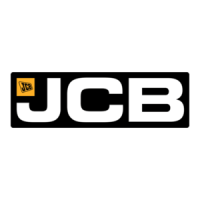
Do you have a question about the jcb G40QS and is the answer not in the manual?
| Model | G40QS |
|---|---|
| Rated Power Output | 3.2kW |
| Voltage | 230V |
| Frequency | 50Hz |
| Fuel Type | Petrol |
| Maximum Power Output | 3.5kW |
| Engine Type | 4-Stroke, OHV, Air Cooled |
| Starting System | Recoil |
Emphasizes the hazardous nature of machinery and the importance of safe operation.
Explains signal words (DANGER, WARNING, CAUTION, Notice) and safety symbols.
Introduces a safety checklist and responsibility for procedures.
Stresses constant vigilance and alertness for hazards during operation.
Provides instructions on how to start the engine using the manual/start button.
Emphasizes the need for adequate training and confidence for safe operation.
Provides safety precautions regarding fuel handling, flammability, and refueling.
Warns against operating a defective or incomplete machine.
Details the procedure for disconnecting the battery, including ECM shutdown wait time.
Outlines the procedure for reconnecting the battery isolator.
Introduces the instrument panel layout and its components.
Details the step-by-step procedure for starting the generator in manual mode.
Explains how to view active Diagnostic Trouble Codes (DTCs) from the engine ECU.
Advises caution with hot engine and machine components before servicing.
Explains how to use the schedules, considering hourly intervals or calendar equivalents.
Details pre-start checks and service points based on operating hours (Table 19).
Explains underspeed and overload protections of the DSR regulator.
Outlines the procedure for removing the air filter elements (Figure 83).
Describes the procedure for installing the air filter, reversing removal steps.
Provides instructions for bleeding the fuel system to remove air and prevent dirt ingress.
Outlines the procedure for replacing the coolant, including draining and flushing.
Details how to safely clean battery terminals and posts.
Details how to safely clean battery terminals and posts.
Lists precautions to prevent damage to the alternator and battery before charging.
Explains fault-finding procedures using flow charts and systematic checks.
Provides troubleshooting steps for engine start issues without exhaust smoke.
Provides troubleshooting steps for engine start issues with exhaust smoke.
States that maintenance must follow handbook requirements and use genuine JCB parts.
Lists warranty terms: 18 months despatch/12 months service, no cross-hire/consequential damage.